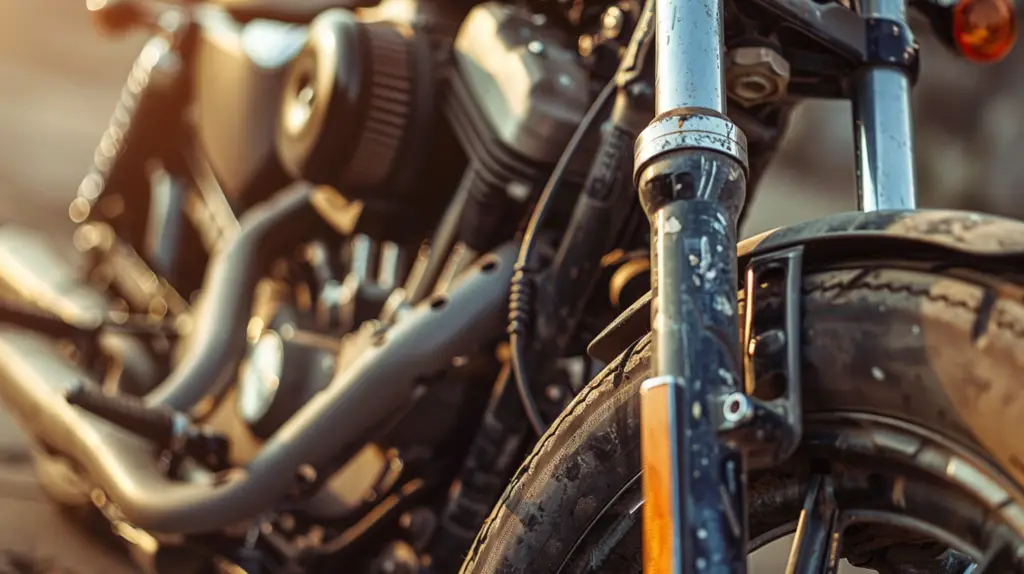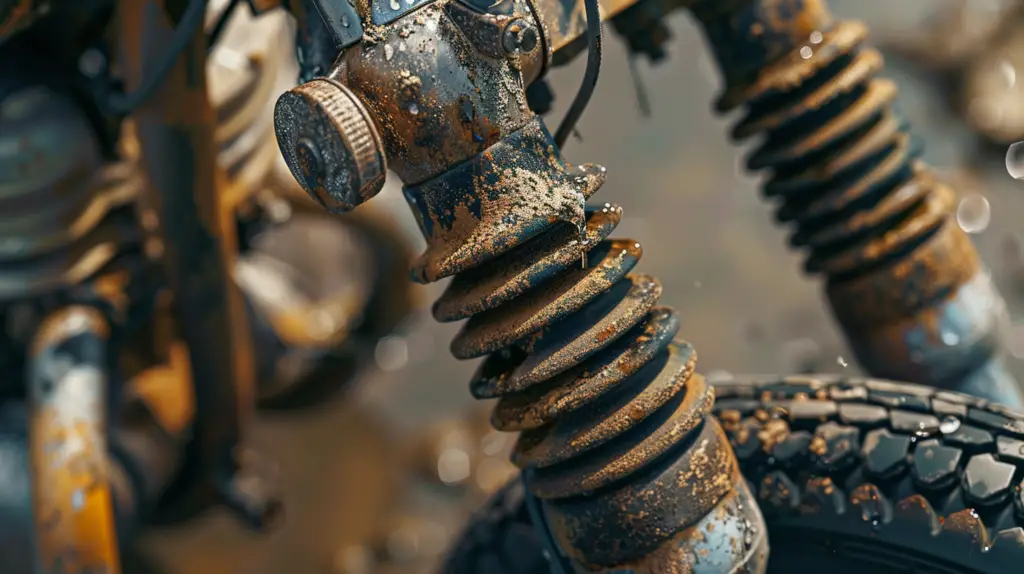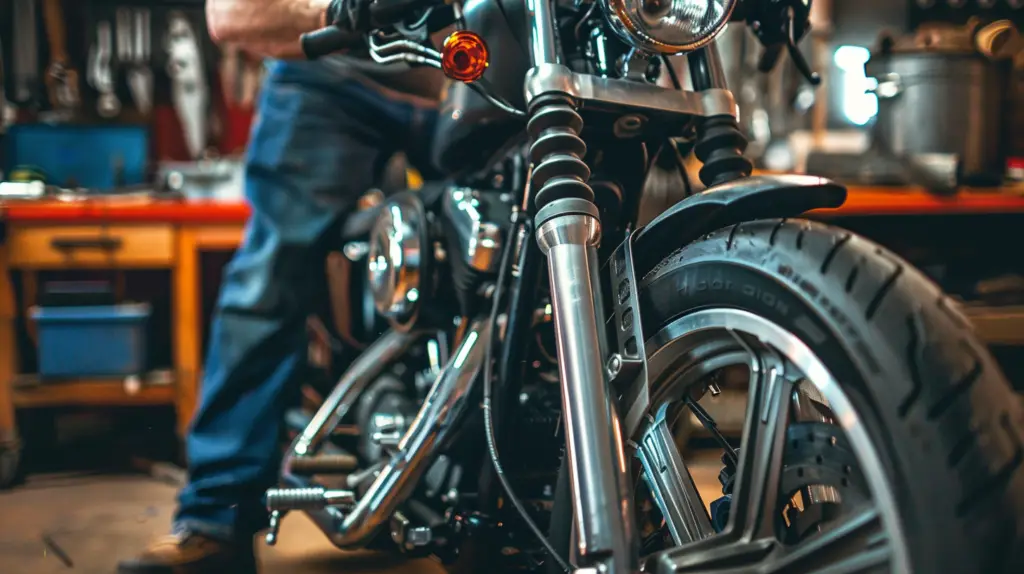You can tackle common Harley-Davidson front fork issues by addressing oil leaks, damaged bushings, and tube misalignment. To stop oil leaks, replace worn fork seals and check for proper lubrication. Damaged bushings cause rough rides, so inspect and replace them if necessary. For tube misalignment, use alignment tools to guarantee stability. Combat front end dive by upgrading to straight rate springs or by using heavier fork oil. Regular maintenance like checking for leaks every 1,000 miles and replacing fork oil every 10,000 miles keeps performance peak. Continue for specific tools and tips.
Read later: Round ‘Em Up: What Year Harleys To Avoid? (Full Overview)
Key Takeaways
- Regularly check and replace fork seals to prevent oil leaks and maintain fork performance.
- Upgrade to straight rate springs and Ricor Intiminators to reduce front end dive.
- Ensure proper fork tube alignment to improve handling and safety.
- Use heavier fork oil for better damping and a smoother ride.
- Clean sliders and seals every 2,000 miles to maintain fork responsiveness.
Common Fork Seal Issues

Over time, you might notice oil seeping from your Harley-Davidson’s front fork seals, signaling potential problems that need immediate attention. This oil seepage often points to fork seal leaks, which can compromise your bike’s fork performance. When seals shrink or wear out, they can’t hold the oil inside the forks properly, leading to leaks that, if left unchecked, can cause significant damage to your ride.
Regularly cleaning and inspecting the fork tubes can help you spot early signs of oil seepage. If you catch a leak early, you can address it before it escalates into a bigger issue. Ignoring fork seal leaks not only affects performance but can also be a safety hazard, as oil can drip onto the front wheel, reducing traction and control.
Sometimes, fixing these leaks requires more than just a DIY approach. Seeking professional assistance guarantees the seals are properly replaced and the forks are rebuilt to ideal standards. A professional mechanic can also identify any underlying issues that mightn’t be immediately visible. By addressing these problems promptly, you maintain your Harley’s performance and ensure a smoother, safer ride.
Damaged Bushings Symptoms
When your Harley’s bushings are damaged, you’ll notice a rougher ride and less responsive steering. Listen for clunking noises and feel for vibrations, especially when hitting bumps.
Inspecting for metal shavings or uneven wear patterns can help you identify bushing wear early.
Rough Ride Indicators
Experiencing a rough ride on your Harley-Davidson often points to damaged bushings, which can cause noticeable noise and vibration. When the bushings in your front forks wear out, they don’t just impact your comfort—they compromise your bike’s performance and safety.
You’ll want to keep an eye out for the following symptoms to make sure your ride stays smooth and liberating.
- Increased Vibration: If you feel more vibration through the handlebars, especially on uneven roads, it’s a strong indicator that your bushings are worn.
- Poor Handling: Damaged bushings can lead to unstable handling, making your Harley-Davidson feel less responsive and harder to control.
- Fork Misalignment: If your front forks appear misaligned or wobbly, it’s likely due to excessive bushing wear, which can affect your suspension’s performance.
- Visible Wear: Upon inspection, if you notice visible bushing wear or damage, it’s a clear sign that replacement is needed.
Noise and Vibration Clues
Noticing strange noises and vibrations while riding your Harley-Davidson often points to damaged bushings in the front forks. When those bushings wear out, you’ll likely hear clunking or rattling noises especially when hitting bumps. That noise isn’t just irritating—it’s a clue that your bike’s handling and stability are at risk.
Damaged bushings cause excess play and looseness in the front forks, making your ride feel rough and unpredictable. You might feel vibrations in your handlebars or notice the front end behaving more erratically than usual. These signs shouldn’t be overlooked, as they can compromise your control and safety.
To maintain your Harley’s peak performance and guarantee a smooth ride, regular inspection is key. By routinely checking your front forks for signs of wear and tear, you can catch damaged bushings before they become a bigger problem. Look out for unusual noises and vibrations, and don’t hesitate to take action when you notice them. It’s about liberating yourself from potential hazards and keeping your ride as exhilarating as it should be.
Take charge of your bike’s health by staying vigilant and proactive. Your Harley deserves nothing less than the best care.
Bushings Wear Detection
Detecting worn bushings in your Harley-Davidson’s front forks often starts with feeling excessive play and hearing abnormal clunking noises. These signs are your bike’s way of telling you that something’s not quite right in the front end. The bushings play an important role in maintaining smooth movement and stability, so it’s essential to catch these issues early.
Here’s how to spot damaged bushings:
- Excessive Play: When you notice more play in the front end than usual, it’s often due to worn bushings.
- Abnormal Movement: If the forks move erratically or don’t respond as they should, the bushings might be the culprit.
- Clunking Noises: Listen for unusual clunking sounds when you hit bumps or brakes. This typically points to bushing wear.
- Uneven Wear Patterns: Inspect the fork tubes for uneven wear patterns, which indicate misalignment caused by damaged bushings.
Addressing these symptoms promptly can prevent further damage and ensure a smoother, safer ride. Regular inspections and maintenance are your best defense against bushing wear and the resulting handling issues. Stay proactive, and your Harley will thank you with reliable performance and freedom on the open road.
Tube Misalignment Problems

Tube misalignment in Harley-Davidson front forks can greatly impact handling and lead to unsafe riding conditions. When your fork tubes aren’t properly aligned, you might notice handling issues that make your ride feel less stable. This misalignment can cause uneven tire wear, reducing the lifespan of your tires and compromising your bike’s performance.
You might also experience steering difficulties, making it harder to control your Harley, especially during sharp turns or sudden stops. The causes of tube misalignment vary, but they often stem from improper installation, worn components, or just plain neglect. Regular maintenance is vital to catch these issues early.
Symptoms to watch for include vibrations, unusual noises, or a sense that your bike isn’t tracking straight. If left unaddressed, these problems can escalate, leading to a rougher ride and increased safety risks. Addressing tube misalignment promptly guarantees smoother, safer rides.
Regularly check your fork alignment and make adjustments as needed. If you’re not confident in your DIY skills, don’t hesitate to seek professional help. Ignoring these signs won’t just hinder your freedom on the open road; it could also jeopardize your safety.
Related Reads
- 21 Years of Road King Problems To Be Aware Of (No, Really)
- 14 Years of Street Glide Problems To Be Wary Of (No, Really)
- 13 Painful Years of Harley Davidson Ultra Classic Problems
- 8 Dreaded Years of Harley Davidson Ultra Limited Problems
- 5 Years of Road Glide Problems To Be Aware Of (No, For Real)
Solving Front End Dive

Addressing tube misalignment is important, but solving front end dive can greatly enhance your Harley-Davidson’s handling and stability. Tackling front end dive isn’t just about comfort—it’s about freedom on the open road.
When you hit the front brake, the last thing you want is for your bike to nosedive, compromising control. Here’s how you can liberate your ride:
- Upgrade to Straight Rate Springs: Unlike progressive springs, straight rate springs offer consistent resistance, reducing front end dive and enhancing stability.
- Change Fork Oil: Switching to a heavier weight fork oil can improve damping, making your front forks more responsive and less prone to diving.
- Install Ricor Intiminators: These innovative dampers fit inside your forks and adjust to road conditions, minimizing front end dive during braking.
- Adjust Suspension Settings: Properly setting your front suspension can make a world of difference. Make sure everything’s dialed in correctly for your weight and riding style.
Routine Fork Maintenance Recommendations
Regularly maintaining your Harley-Davidson’s front forks guarantees a smoother ride and prolongs the life of your suspension components. Start by inspecting your forks for any oil leaks, as these can compromise your bike’s handling and safety. Clean the fork sliders and seals to prevent dirt buildup, which can cause premature wear and leaks.
Fork oil maintenance is essential. Check the oil levels and replace the oil at the intervals recommended by the manufacturer. Fresh oil ensures your suspension remains responsive and smooth. Also, make sure the forks are properly aligned to avoid unnecessary stress on the components.
| Maintenance Task | Frequency |
|---|---|
| Check for oil leaks | Every 1,000 miles |
| Clean sliders and seals | Every 2,000 miles |
| Replace fork oil | Every 10,000 miles |
| Inspect fork alignment | Every 5,000 miles |
Professional Diagnostic Tools to Have in Your Arsenal
When dealing with Harley-Davidson front fork issues, you’ll find that professional diagnostic tools are essential. These specialized instruments help you identify hidden problems that aren’t visible during a regular inspection.
Specialized Diagnostic Instruments
For accurate diagnosis and maintenance of Harley-Davidson front forks, investing in specialized diagnostic instruments like fork seal drivers and alignment tools is essential. These professional diagnostic tools guarantee you can keep your bike in top condition, freeing you from frequent trips to the mechanic.
- Fork Seal Drivers: These tools help you properly seat fork seals, preventing leaks that can compromise your ride. Without a fork seal driver, you might end up with improperly seated seals, leading to oil drips and a messy front wheel.
- Fork Oil Level Gauges: Maintaining the correct fork oil level is vital for performance and longevity. Fork oil level gauges let you measure and adjust the oil precisely, ensuring smooth handling and avoiding excessive front-end dive.
- Fork Tube Alignment Tools: Misaligned fork tubes can wreak havoc on your bike’s stability. Fork tube alignment tools help you ensure that your forks are perfectly aligned, resulting in a smoother and more controlled ride.
- Professional Diagnostic Tools: Investing in these tools enhances the efficiency and accuracy of your maintenance efforts. With the right diagnostic instruments, you can address issues directly, ensuring your Harley-Davidson remains a symbol of freedom on the open road.
Identifying Hidden Issues
Professional diagnostic tools like fork seal drivers and spring compressors are essential for uncovering hidden issues in your Harley-Davidson’s front forks. These tools give you the power to dig deep and spot problems that might be missed during a casual inspection.
When you’re chasing that perfect ride, precision matters. Spring compressors let you safely disassemble the front forks, allowing you to inspect internal components like bushings, seals, and springs. Using diagnostic tools ensures you’re not just guessing but actually identifying what’s causing that rough ride or stiff steering.
Fork oil level gauges are another critical instrument. They help you measure the exact oil level, ensuring your forks perform at their best. Low or uneven fork oil levels can lead to excessive front-end dive or poor handling on bumps. By using these gauges, you’ll maintain the perfect balance for a smoother, more responsive ride.
Sometimes, the issues are subtle—like slightly worn fork tubes or minor misalignments. Diagnostic tools help you catch these early, preventing bigger problems down the road. So, liberate yourself from the guesswork. Embrace these professional tools to make sure your Harley-Davidson’s front forks are in excellent condition.
Steps to Enhancing Fork Performance
Upgrading to straight rate springs can drastically enhance your Harley-Davidson’s front fork performance, giving you a smoother and more controlled ride. When you swap out those stock springs for straight rate ones, you’re tackling front end dive and improving handling.
Pair this upgrade with heavier oil, and you’ll notice a significant boost in bump absorption and overall ride quality.
To get the most out of your front forks, consider the following steps:
- Upgrade to Straight Rate Springs: This change provides consistent performance across different loads and road conditions.
- Add Ricor Intiminators: These devices minimize brake dive and enhance handling, making your ride smoother and more responsive.
- Switch to Heavier Oil: Heavier oil improves dampening, making your bike handle bumps and rough terrain with ease.
- Regular Maintenance: Keep your front forks in top condition by regularly checking for leaks, alignment, and wear.
Conclusion
By staying vigilant, performing regular maintenance, and addressing issues promptly, you’ll maintain your Harley-Davidson’s front forks in top shape. Spot leaks early, replace worn bushings, realign misaligned tubes, and tackle front end dive head-on.
Use professional diagnostic tools when necessary, and always aim to optimize fork performance. With these steps, you’ll guarantee smoother rides, better handling, and increased safety.
Take charge of your bike’s care and enjoy every journey to the fullest.




Leave a Reply
You must be logged in to post a comment.